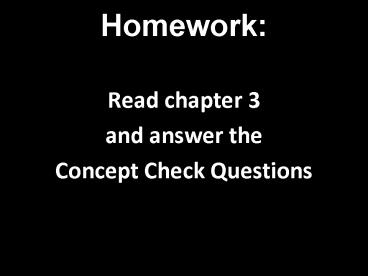Homework: PowerPoint PPT Presentation
1 / 32
Title: Homework:
1
Homework
Read chapter 3 and answer the Concept Check
Questions
2
Survival of the fittest
3
The fitness of the environment
- Life adapts to its environment through natural
selection - The environment must be a suitable abode for
there to be life at all.
4
Water
- Hydrogen bonding
- Emergent qualities
- Dissociation leads to acidic and basic conditions.
5
Hydrogen Bonding
- Oxygen is more electronegative than hydrogen
- Oxygen in water is partially negative hydrogen
partially positive.
6
Emergent Properties
- Cohesion
- Moderation of temperature
- Expansion upon freezing
- Versatility as a solvent.
.
7
Mole
8
Mole
- Take the atomic mass, say it in grams, and its a
mole.
9
Mole
- Take the atomic mass, say it in grams, and its a
mole. - 6.02 x 1023 AMU 1 g
10
Mole
Take the atomic mass, say it in grams, and its a
mole.
One atom of water
11
Mole
Take the atomic mass, say it in grams, and its a
mole.
1 AMU
1 AMU
16 AMU
One atom of water
12
Mole
Take the atomic mass, say it in grams, and its a
mole.
1
1
18 AMU
16
One atom of water
13
Mole
Take the atomic mass, say it in grams, and its a
mole.
18 g
One mole of water
14
Molar
One molar equals one mole of solute per liter of
solution
1 M 1 mole/L
15
Molar
One molar equals one mole of solute per liter of
solution
Na 23 AMU Cl 35.4 AMU NaCl 58.4 AMU
16
Molar
One molar equals one mole of solute per liter of
solution
Na 23 g Cl 35.4 g NaCl 58.4 g
17
Molar
One molar equals one mole of solute per liter of
solution
1 L
58.4 g
18
Molar
One molar equals one mole of solute per liter of
solution
1 L
58.4 g
19
Molar
One molar equals one mole of solute per liter of
solution
1 L
58.4 g
20
Molar
One molar equals one mole of solute per liter of
solution
1 L
58.4 g
21
Molar
One molar equals one mole of solute per liter of
solution
1 L
1 M 1 mole/L
58.4 g
22
Dissociation
- H for pure water at 25oC 10-7 M
- pH -log H
- More H means more acidic
- 1 pH unit 10x change in acidity.
23
Buffers
- Minimize changes in pH
- Usually a weak acid and its corresponding base.
24
Oil and water do not mix
- Why not?
- Can we make them mix?
25
Polar and Non-Polar
- Water has polar covalent bonds
- Oil has non-polar covalent bonds
- Soap has both.
26
Phospholipids
27
Selective Permeability
- Hydrophobic molecules dissolve in the lipid layer
and cross it easily - Hydrocarbons (oils), CO2, O2.
28
Selective Permeability
- Hydrophilic molecules are blocked by the lipid
layer - Ions, water, etc
- Cell uses transport proteins to carry hydrophilic
substances.
29
Passive Transport
- Diffusion
- Concentration gradient
- No energy is expended
- Osmosis diffusion of water.
30
Osmosis
- Water moves from hypotonic solution to hypertonic
solution - Isotonic same concentration
- Water potential includes solute concentration
and pressure.
31
Osmosis
- hypo
hyper
32
Osmosis
- hypo
hyper
.

